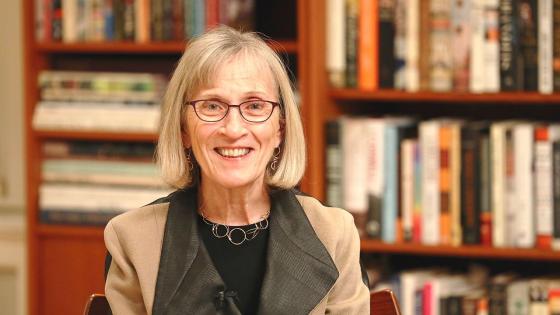The Nobel Committee has awarded this year’s Sveriges Riksbank Prize in Economic Sciences in Memory of Alfred Nobel to Claudia Goldin “for having advanced our understanding of women’s labour market outcomes”. Indeed, Claudia’s contributions to the topic are vast, perhaps best epitomised by her 1990 book Understanding the Gender Gap.
This book illustrates at once her rigor as a University of Chicago-trained PhD as well as her own determination to use the tools of economics to understand a topic that the (mostly) men of her cohort had overlooked. She once joked to us that while writing the book she had Gary Becker whispering in one ear to place gender gaps in the context of price theory and Dick Easterlin whispering in the other ear to take painstaking care with the data collection and analysis.
Although we believe that the committee rightly honours this work, what has been lost in the celebration, in our view, is that Claudia’s work on gender gaps is part of a larger agenda of understanding inequality in the labour market. Of course, women make up half of the population, and before Claudia’s pathbreaking work, we knew so little about this ‘other half’, so her work on gender alone justifies the prize.
But we believe that her work on gender is better understood and appreciated by placing it in the larger context of her research on labour markets. We are two of Claudia’s many PhD advisees who do not primarily work on gender, but whose research nonetheless benefited tremendously from her economic intuition and her keen sense of open and important research questions.
As a student of Gary Becker, Claudia viewed the gender gaps in employment and wages as equilibrium labour market outcomes. The supply of women potentially interested in market work would interact with firms’ demand for such work to produce an equilibrium wage and level of employment, and similar forces would work for men. If fewer than 10% of married women worked for pay in the US in 1910, and close to 60% of married women do so today, the explanation must be that either the supply of married women interested in seeking paid work had increased, or the demand for women’s labour had increased, or both.
But that same basic logic applies to any other type of labour market outcome, not just those related to gender. In particular, Claudia (along with Larry Katz) was a leading figure in tying changes in the supply and demand for skilled labour to the evolution of the gap in earnings between more- and less-educated workers and to economic inequality more generally.
Of course, Claudia’s experience as an economic historian taught her that the real world does not function as smoothly as economic models assume. So alongside supply and demand, she emphasised the centrality of institutions (laws, customs, etc.) in shaping the wage and employment levels that we ultimately observe.
One pithy way in which Claudia used to explain the evolution in demand for women’s labour is that “women have a comparative advantage over men in ‘brain’ work and men have a comparative advantage in ‘brawn’”. As the economy shifted from agricultural and manufacturing to services, the relative demand for women’s work increased.
Even within manufacturing, the transition from the first industrial revolution taking place largely in non-electrified factories, to the capital-intensive sectors of the second industrial revolution – industries like steel, and eventually aircraft and motor vehicles, as well as food processing, petroleum and chemicals – favoured higher-skilled workers over lower-skilled, and thus contributed to a shift in relative demand for women over men. Although women may not have worked in large numbers on the factory floor, these new technologies required engineers to install and fix complex machinery, and large numbers of white-collar workers to process orders and keep the books (Goldin and Katz 1998). Women filled many of these office jobs as secretaries, stenographers, typists and telephone operators.
Claudia’s work analysing the ‘skill premium’ (the additional earnings gained by more educated workers) uses the same framework and, in our view, is just as influential and important as her work on gender gaps. Claudia’s 2008 book with Larry Katz – The Race Between Education and Technology – provides a unifying framework for understanding the rise and fall and then rise again of income inequality over the twentieth century.
As the demand for high-skilled work increased with the second industrial revolution in the 1910s and 1920s, pay for higher-skilled workers at the top of the income distribution rose. Technological developments that favoured less-skilled workers – an important example being the assembly line and other Fordist advances – helped to usher in a period of more accelerated growth at the bottom of the distribution (alongside legal and institutional reforms such as the rise of unions). In fact, Claudia’s 1992 paper (co-authored with Robert Margo) is one of the most important empirical contributions to the modern US economic inequality literature, and in much of that analysis, she focuses only on men.
Of course, labour demand is at most half the story, and Claudia has made numerous contributions to understanding labour supply. All else equal, an input in ample supply enjoys lower returns, and Claudia thus argues that a major force reducing the skill premium in the mid-century decades was a massive increase in educated workers.
This large shift in the supply of skill was due to the high school movement, a period between 1910 and 1940 during which small towns and cities around the United States decided to raise property taxes to fund an expansion in publicly provided schools (Goldin 1998). It is due to Claudia’s detailed data work that we know where and when the first of these high schools opened, what the curriculum covered, and how they were funded.
We should not take it for granted that these high schools would have been open to both boys and girls, but they were. And it is notable that despite facing similarly rising returns to education, European countries did not provide public high schools in large numbers until after WWII – delayed, as Claudia argues, by their centralised funding mechanisms.
Alongside the high school movement, Claudia credits the surge in educated men that the GI Bill produced in further increasing the supply of skill and thus driving down the skill premium after WWII, ensuring that the period of massive post-war economic growth would not be concentrated only at the top.
One of the fascinating questions raised by Claudia’s work and the framework of the race between education and technology is why, when faced by a new period of skill-biased technological change in the 1980s driven by computerisation and new communication technologies, we have not seen a similar response by governments – either local or at a higher level – in the US to fund colleges and universities publicly.
One of the themes that emerges from Claudia’s work on technology and the demand for skill is that the rise in computers is not the first time a ‘disruptive’ technological development has reshuffled the labour market. The first and second industrial revolutions, the rise of electrification, the massive gains to agricultural productivity that sharply reduced the demand for farm work – these developments also disrupted old ways of organising work. In the past, the government facilitated massive education expansions to help workers adapt to these changes – the high school movement and then the GI Bills – but we have not seen such efforts in recent decades.
Just as Claudia’s work shows how the supply of skilled workers helps to explain overall earnings inequality over the twentieth century, it also documents how supply issues help to explain the gender gaps in labour market outcomes. Women were initially excluded from the labour market by “social stigma, legislation and other institutional barriers”, and then entered the labour force in great numbers as these norms shifted.
A major part of that shift, especially for more educated women, was driven by the contraceptive revolution that allowed women to plan for education and careers. As the press release extolling Claudia’s prize summarises her work: “The pill meant that women could better plan their future… giving them entirely new incentives to invest in their education and careers.” Her 2002 paper with Larry Katz shows that laws that gave access to the pill to unmarried women increased both the average year of first birth as well as the share of women pursuing long-duration professional education (Goldin and Katz 2002).
Much of Claudia’s work on both gender gaps and inequality more generally has focused on the role of education, and perhaps it is thus no surprise that she is the consummate teacher, adviser and mentor.
How lucky we were, as young graduate students, to interact on a daily basis with a scholar as prodigious, as insightful and as deeply curious as Claudia Goldin – and we do mean daily! Our cubicles were near her office at the NBER. We would delight in meeting her in the coffee room, where she would nibble at a bagel, page through the New York Times, and ask the most penetrating questions about what was going on in the world, why things were organised the way they were, and how funny and bizarre the world could be.
If Claudia had Gary and Dick on her shoulder while writing Understanding the Gender Gap, we will perennially have Claudia on our shoulders as we write our own scholarship and advise our students – now often together, in advisee meetings that remind us (on our best days!) of Claudia’s combination of academic rigor, interpersonal care and curiosity, and zany sense of humour.
We will always take to heart the comments that Claudia marked in red in the margins of our papers, including a number of indelible grammar tips (“since always refers to time!” and “don’t use while when you mean although!”). And we will forever appreciate the many ways that Claudia cared about us not only as students but as whole people with families and worries and commitments.
Claudia’s mentorship went beyond her PhD advisees. She led the Development of the American Economy (DAE) programme at the NBER for over 25 years. While the growth of NBER working papers in general was incredibly robust during this period, the papers produced for the DAE program grew even more rapidly. And yet the group never lost its intimacy.
We are honoured to share the experience of Claudia’s mentorship with so many other students and honorary students that she took under her wing, as well as with the whole field of economic history that was nurtured and came to flourish under her leadership. And while we hope we have demonstrated that Claudia’s intellectual influence goes far beyond the study of gender gaps, at the same time it is undeniable that she inspired countless women to pursue the study of economics. We are so lucky to be among them.
References
Goldin, C (1990), Understanding the Gender Gap: An Economic History of American Women, NBER/Oxford University Press.
Goldin, C (1998), "America's Graduation from High School: The Evolution and Spread of Secondary Schooling in the Twentieth Century", Journal of Economic History 58(2): 345-74.
Goldin, C, and LF Katz (1998), "The Origins of Technology-Skill Complementarity", Quarterly Journal of Economics 113(3): 693-732.
Goldin, C, and LF Katz (2002), "The Power of the Pill: Oral Contraceptives and Women’s Career and Marriage Decisions", Journal of Political Economy 110(4): 730-70.
Goldin, C, and LF Katz (2008), The Race Between Education and Technology, Harvard University Press.
Goldin, C, and RA Margo (1992) "The Great Compression: The Wage Structure in the United States at Mid-century", Quarterly Journal of Economics 107(1): 1-34.



